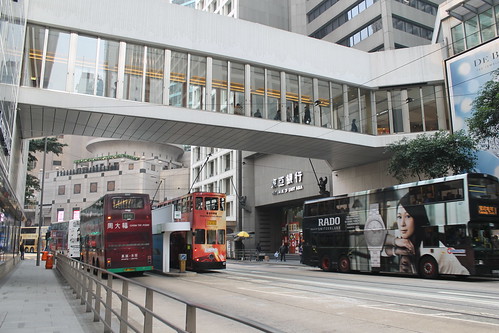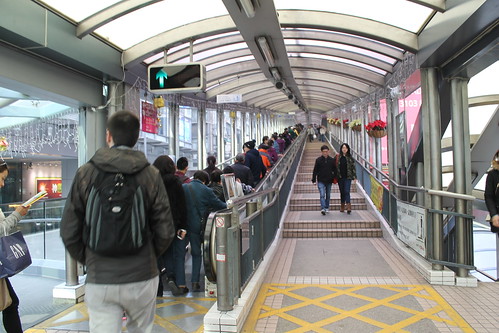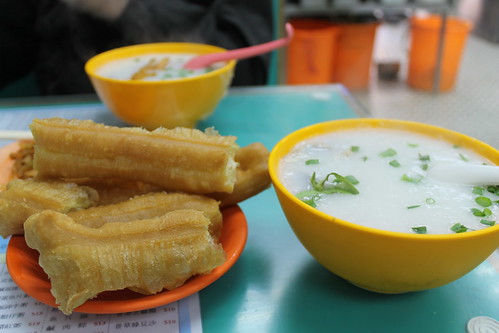It’s impossible to cram five days of Hong Kong into a single blog post, but I’m going to try anyway. For a Christmas vacation, this was pretty darn good! I took a billion pictures of food, buildings, and road signs, which can all be found in World Tour, Vol. 4: Hong Kong.

Hong Kong itself is a fascinating and bewildering mixture of Eastern and Western cultures. How? Here’s a a five-second view of its history: Hong Kong became a British colony in the mid-1800’s because Qing Dynasty China lost the Opium Wars. A treaty negotiated in 1898 gave the British a formal 99-year lease, and in 1997, the whole region was transferred back over to China. So legally and culturally speaking, it’s something of a unicorn: it is now legally a Special Administrative Region (SAR) of the People’s Republic of China, but operates under a completely different currency ($1 USD = $7.75 HKD) and trade system. You don’t need a Chinese visa to get in with a U.S. passport. Most people speak Cantonese Chinese, as a result of massive immigration from neighboring Canton/Guangdong Province throughout the ’30s – ’60s, but also understand Mandarin Chinese. If they speak English, it’s likely to have a British accent. Most of the streets have Chinese names as well as British ones, but people drive on the left, and buses and trams are double-deckers. If that wasn’t enough, Hong Kong is also geographically challenged — it is made up of a dozen or so hilly islands, so its flatter, more habitable portions are very vertically developed, and with 7 million people, is one of the most densely-populated areas on earth.
As a cosmopolitan world center of culture and finance, Hong Kong has pretty much everything that you could possibly want to eat or buy. You want a genuine bagel? You want a bowl of preserved egg congee? Artisanal coffee? Aloo mutter? Eggs benedict? We enjoyed all those things. It’s just likely to be hidden in a building off the main road, on an indecipherable menu, for U.S. prices, and on a fourth-floor walk-up. A great example is the most delicious Indian food I’ve ever tried. Branto Pure Veg is nestled on the second floor of a building on Lock Rd., across from the iSquare, and a stone’s throw from the Chungking Mansions. Erin and Kate, who found it when they studied abroad in Hong Kong, recommended it to us, and we visited last October when we took a trip to China. When I had their vegetable curry, I finally understood what Indian food in the United States had been trying to tell me for years. The paper masala dosa and mango lassi also made me weak at the knees. So last week, Steve and I made a beeline there for our Christmas dinner, and we made it just in time. When we were getting ready to leave, there was a line of Indian families out the door. If you have the chance to visit Hong Kong, I would not leave without trying Branto.
We stayed at the Dorsett Mong Kok, a hotel on the Kowloon Peninsula. The rooms were tiny, which is to be expected in a densely-packed city like Hong Kong, but full of good amenities. We had a large beautiful window which looked out on several rooftops next door as well as a stunning skyline, and Steve loved the automatic window blind, which he said made him feel like he was in Blade Runner. On Sunday morning, when we got up, we saw about five or six people on one of the rooftops training in martial arts with swords, staffs, and nunchucks. That’s Hong Kong for you.
One of our most exciting experiences in Hong Kong was simply riding the Central to Mid-Levels Escalators. Hong Kong is home to the longest covered outdoor escalator and walk-way system. It brings you from Central MTR Station halfway up the mountain of Victoria Peak on the north side of Hong Kong Island, and takes about half an hour to cover thoroughly. It’s a fun way to see a slice of Hong Kong life, with many different restaurants, cafés, and businesses. After taking it all the way up, we walked halfway down and had pizza and hot Hong Kong milk tea at a place to people watch. We sat next to a British couple and a mixed Chinese-American family, but also a bunch of Chinese businessmen and a few Hong Kong women out for ladies’ night. It’s one of those cities in the world that you wouldn’t be surprised at hearing four different languages in a single restaurant.
The day before we left, we visited Victoria Peak. Historically, it was the high point of Hong Kong Island, and inhabited more by the upper-class Europeans who lived in Hong Kong. These days, luxury condos are all over the north side of the island (and increasingly, the south as well), and the Peak is home to beautiful natural parks as well as a small shopping mall that draws millions of visitors each year for its gorgeous view of the harbor and Kowloon Peninsula to the north. We made our way up via Bus 15, a local bus route, and were fortunate enough to find second-row seats on the second level of the double-decker. The entire journey was like a roller coaster ride, made at what seemed like breakneck speed for the narrow, twisting roads that went up the mountain. From that height, it’s easy to constantly feel like you’re about to collide or run right over smaller cars and pedestrians, but it also provides amazing views of the hills below. I spent the entire ride alternating between taking photos and making high-pitched whining noises because it looked like we were going to just sail right off the precarious mountain path into the trees below. Steve spent most of the time laughing at me. It also was the most cost-effective way of getting to the peak, at a measly $9.80 HKD. We took it back down and waited for a later bus just to get the front-most seats, where I took some photos in hopes of conveying the edge-of-your-seat feel of being at the very top.
In the morning, we had a bowl of delicious congee and youtiao (油条) or fried cruller with some pickled vegetables, and were off to the airport. I’ll miss Hong Kong, but we have many more places to go. Happy New Year to everyone, and we’ll post more soon about our plans for the first part of 2014!
Best,
Connie





